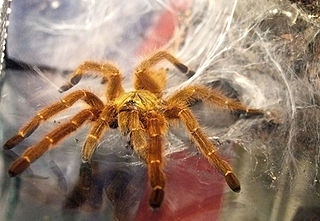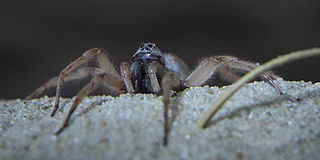
Ground spiders comprise Gnaphosidae, the seventh largest spider family with over 2,000 described species in over 100 genera distributed worldwide. There are 105 species known to central Europe, and common genera include Gnaphosa, Drassodes, Micaria, Cesonia, Zelotes and many others. They are closely related to Clubionidae. At present, no ground spiders are known to be seriously venomous to humans.

Oonopidae, also known as goblin spiders, is a family of spiders consisting of over 1,600 described species in about 113 genera worldwide, with total species diversity estimated at 2000 to 2500 species. The type genus of the family is OonopsKeyserling, 1835.

Migidae, also known as tree trapdoor spiders, is a family of spiders with about 100 species in eleven genera. They are small to large spiders with little to no hair and build burrows with a trapdoor. Some species live in tree fern stems. They have a Gondwanan distribution, found almost exclusively on the Southern Hemisphere, occurring in South America, Africa, Madagascar, Australia, New Zealand and New Caledonia.

The Harpactirinae are a subfamily of tarantulas which are native to the continent of Africa. Like many Old World tarantulas, they have a relatively strong venom, and can inflict a painful bite.

Hogna is a genus of wolf spiders with more than 200 described species. It is found on all continents except Antarctica.
Moggridgea terrestris is a spider species in the genus Moggridgea. It is found in South Africa.

Allocosa is a spider genus of the wolf spider family, Lycosidae. The 130 or more recognized species are spread worldwide.

Idiops is a genus of armored trapdoor spiders that was first described by Josef Anton Maximilian Perty in 1833. It is the type genus of the spurred trapdoor spiders, Idiopidae. Idiops is also the most species-rich genus of the family, and is found at widely separated locations in the Neotropics, Afrotropics, Indomalaya and the Middle East. Females live in tubular burrows lined with a thick layer of white silk. These typically have a D-shaped lid that fits into the entrance like a cork, and some burrows have two entrances. The lid may consist of mud, moss or lichen, which is bound below by a thick layer of silk. As in all genera of this family, the anterior lateral eyes (ALE) are situated near the clypeal margin, far in front of the remaining six eyes, which are arranged in a tight group. The males which are smaller in size, wander about or occasionally live in burrows. Like other mygalomorphs, they are relatively large and long-lived. Forest clearance and agricultural practices that loosen the soil and enhance erosion, besides soil removal for brick making have been pointed out as serious threats to some Indian species. Species ranges are poorly known – in India for instance, most species are known only from their type localities.
Galeosoma is a genus of African armored trapdoor spiders that was first described by William Frederick Purcell in 1903.

Stasimopus is a genus of African mygalomorph spiders that was first described by Eugène Louis Simon in 1892. It is the only genus in the family Stasimopidae.
Ancylotrypa is a genus of African wafer trapdoor spiders that was first described by Eugène Simon in 1889. Originally placed with the Ctenizidae, it was moved to the Cyrtaucheniidae in 1953.
Homostola is a genus of African mygalomorph spiders in the family Bemmeridae. It was first described by Eugène Louis Simon in 1892. Originally placed with the Ctenizidae, it was transferred to the wafer trapdoor spiders in 1985, and to the Bemmeridae in 2020. It is a senior synonym of Stictogaster and Paromostola.
Hermacha is a genus of mygalomorphae spiders in the family Entypesidae. It was first described by Eugène Louis Simon in 1889. Originally placed with the Ctenizidae, it was transferred to the funnel-web trapdoor spiders in 1985, then to the Entypesidae in 2020. It is a senior synonym of Damarchodes and Hermachola.
Spiroctenus is a genus of African araneomorph spiders in the family Bemmeridae. It was first described by Eugène Louis Simon in 1889. Originally placed with the Ctenizidae, it was transferred to the funnel-web trapdoor spiders in 1985, and to the Bemmeridae in 2020. It is a senior synonym of Bemmeris, Bessia, and Ctenonemus.
Cydrela is a genus of spiders in the family Zodariidae. It was first described in 1873 by Thorell. As of 2022, it contains 17 species from a variety of places in Asia and Africa.
Blossia is a genus of daesiid camel spiders, first described by Eugène Simon in 1880.








